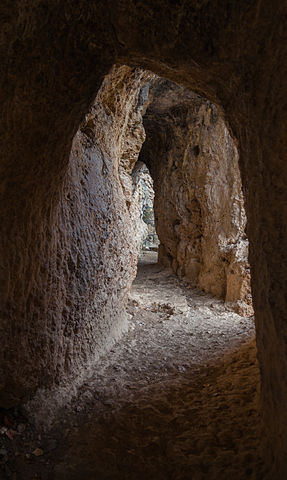From the Archives: History’s Arc of Innovation

My good friend Jeff Mann, the true Yard Ramp Guy, has asked me to revisit some of my original contributions. And so: my From the Archives series. This week: not to go all Ripley on you...but, believe it or not, I have a list of amazing inventions.
I always hear people going on and on about how we're in the greatest age of innovation and technology, with more amazing things being invented now than ever before. I'll have to beg to differ there, and I can back up my argument, too:

The Library at Alexandria
The oldest folding chairs date back to the 14th century B.C. from Ancient Egypt.
The first fishing reel dates all the way to at least 4th century China.
Beer predates recorded history, and has even been linked to the rise of civilization.
Wine predates recorded history and is possibly almost as old as beer.
Reclining armchairs date back to the Napoleonic War.
Organized sporting events predate recorded history.
The oldest dice ever found are more than 5,000 years old—coincidentally, they were found in the oldest ever backgammon set.
Humans bred dogs before recorded history, or even the invention of agriculture.
The earliest form of chess originated in the 6th century in India.
The Arawak Native Americans invented the barbeque grill long before any Europeans showed up in the Americas.

Yours Truly, Daydreaming Up Some Inventions of My Own
Playing cards were invented in China during the 9th century.
The written word is between six and nine thousand years old; the first proto-books popped up not too long after.
The housecat was domesticated in Ancient Egypt, though some experts believe that the process started long before that.
The oldest known direct ancestors of the guitar are well over 3,000 years old.
Baseball caps are more than a century and a half old.
People began drinking coffee—in Yemen—in the 1400s.
Native Americans, probably the Arawak, invented the hammock in the Caribbean more than a thousand years ago.
So, the next time someone dismisses ancient peoples as primitive: just smile and nod, then kick back in a hammock with a beer and a good book.
The Yard Ramp Guy Blog: Material Handling Statistics
This week, my friend The Yard Ramp Guy describes how the Confidence Index is monitoring the pulse of the material handling industry. It's surprising, and in a positive way, given what's happening in the world.
Click HERE to read all about it.

From the Vault: The Mark of Civilization

My good friend Jeff Mann, the true Yard Ramp Guy, has asked me to revisit some of my original contributions. And so: my From the Archives series. This week: Aqueducts and pyramids and highways, oh my.

Roman Aqueduct, c. 1st century, Spain
When you think about the Roman Empire, one of the first things that pops into mind is their aqueduct system…unless you've been watching too much TV, in which case you’re likely thinking of their gladiators or legions.
I feel pretty comfortable saying that the reason Rome was so stable for so long was due to their roads, aqueducts, sewer system, and other civil projects. It always grates me a little bit when people talk about the gladiatorial games being used to pacify the population—they certainly did that, but this was secondary to having clean water, plenty of food, and sanitation.
Thanks to the Roman Empire's extensive civil improvements, Rome itself had a population of more than a MILLION people. That's just nuts for a city in the ancient world. Athens maybe had 300K, and it was enormous for its time. There are only a few other ancient cities of comparable size at all.
That's where Rome's real success lay: not in conquest but in civil planning and construction. I know I'm starting to sound like a broken record in this blog space, going on about how people focused on war as the key part of history bugs me. (Maggie jokes sometimes that she is worried I'll start buying Grateful Dead shirts and growing a ponytail.) It's not about hating war, though. It's about acknowledging that what we build and how we build it is, ultimately, the most important legacy of a society.
Eisenhower's greatest accomplishment as President? The Interstate Highway System. What do we remember about the Egyptians? The pyramids. If you look at any society from more than a couple decades or so, what part of it lasts? Their construction.
The aqueducts have stood for millennia. I rest my case.
__________
Photo: Diego Delso, delso,photo, License CC-BY-SA
The Yard Ramp Guy Blog: A Stadium View
This week, my friend The Yard Ramp Guy, without bragging (not his style), highlights yard ramp placement with high-profile sports teams and what he calls "service without complaint, needing virtually no maintenance, and readily repositioned to be placed into and out of service when needed." Bravo, I say.
Click HERE to read all about it.

From the Vault: Franz and Kinematics

My good friend Jeff Mann, the true Yard Ramp Guy, has asked me to revisit some of my original contributions. And so: my From the Archives series. This week: A screw is basically an inclined plane. And that's no joke.
Simple machines are the basis of industry. Well, sorta.

No screw loose...but that basket's about to fall.
A simple machine is a device used to change the direction or power of a force applied to something in the simplest manner possible. There are six devices classically categorized as simple machines: axles and wheels, levers, pulleys, screws, wedges, and inclined planes (obviously the best).
The reason I said they're only sorta the basis for industry, though, is that the idea of simple machines is itself an oversimplification.
First off, take a look at wedges and screws. A screw is nothing more than an inclined plane wrapped around a cylinder. When you're turning a screw, picture it inside the material—climbing up or down the ramp—as the screw turns. Wedges are just two ramps hooked up to one another, bottom to bottom, for use in transferring force perpendicularly.
Ramps make up half of the classical simple machines. Ramps rule, but we already knew that.
Then you come to wheels and axles and pulleys. A pulley is just a wheel and axle with a rope attached. It's still super useful, of course.

One small step for man...and that's about all.
At first glance, our final classical simple machine, the lever, is pretty distinct from the others. A guy named Franz Reuleaux, however, realized that, like the wheel and pulley, the lever is just a body rotating about a hinge. Reuleaux was also the one who figured out that the screw, wedge, and inclined plane were the same. Really smart cookie.
So all in all, you've really got two simple machines and four variants on the original list. And that’s the first issue with describing the classical simple machines as the basis of mechanical industry.
The second issue? There are a lot more than six simple machines. You've got four-bar linkages and cranks, for example. Our good buddy Franz identified hundreds of simple machines using his self-invented science of Kinematics, which we still use today. Way to go, Franz. Not bad for a guy born in 1829.
Nowadays, thanks to Franz and Kinematics, we actually consider joints the basis of mechanics, but that's a story for another day.
The Yard Ramp Guy Blog: New Inventory - In Stock
This week, my friend The Yard Ramp Guy has launched a smart, strategic arm of his business: selling new yard ramps that are in stock and ready for delivery. I do admire his strategy.
Click HERE to read the smart details.

From the Archives: On Runaway Truck Ramps

My good friend Jeff Mann, the true Yard Ramp Guy, has asked me to revisit some of my original contributions. And so: my From the Archives series. This week: Honoring runaway truck ramps.
If you've ever taken I-70 through the Rockies, you've probably seen those steep gravel turnoffs leading up from the road, then abruptly dead-ending, as well as all the signs advertising them.

A Fields Inspection
Those are runaway truck ramps, and they're for semis whose brakes have blown.
The idea is pretty simple: an out-of-control truck can't stop, so the driver keeps his foot off the gas, waits for a truck ramp, then expends all the truck’s momentum going up it.
In practice, though, these ramps are pretty complicated.
First off, you've got to make sure the truck won't roll back down. One way to do that is to have a long flat stretch after an initial rise (though this obviously doesn't work in the Rockies).
Another version uses sand to absorb all the momentum: semi tires are big, but not big enough to take a semi through sand. The problem with sand ramps is that the semis have a tendency to flip on them.

A Glass of McCoy
Finally, there are the ones made of loose, ungraded gravel. They work great but rip up tires and undercarriages.
Steep gravel ramps—like the ones on I-70 are the most common. Moderate damage is better than overturning or rolling back onto the road. It's not an overly complicated issue, but the sheer force of a fast-moving semi complicates the solution, especially since they're nowhere near as durable as they are in movies.
All of that said: never, ever drive a non-semi vehicle up there. It will not survive.
The Yard Ramp Guy Blog: New Angles on Leasing Ramps
This week, my friend The Yard Ramp Guy emphasizes a simple⏤and often vital⏤way for your business to keep cash on hand. Especially in these troubled and troubling times.
Click HERE to read all about it.






